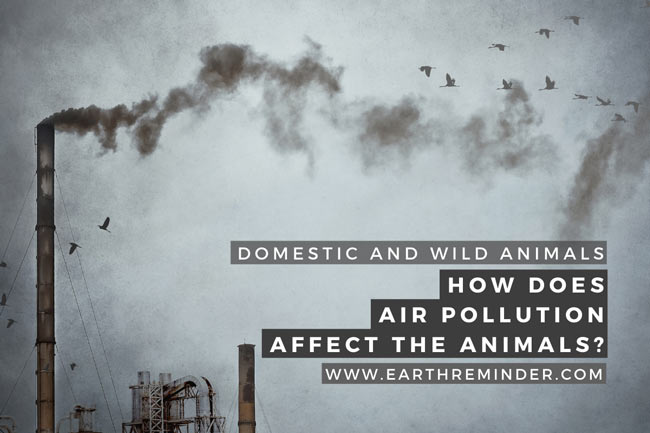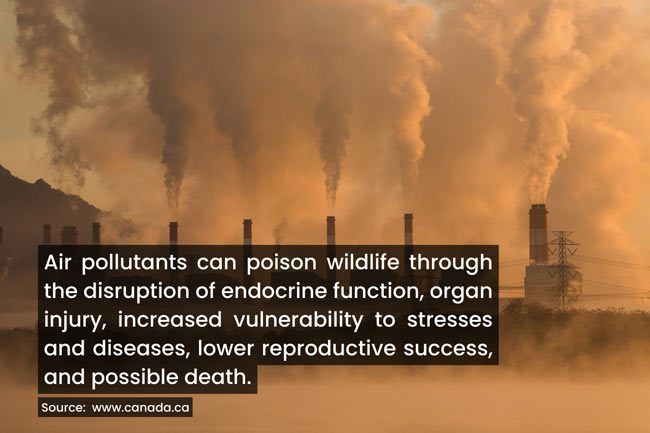How Does Air Pollution Affect the Animals?
Effects of Air Pollution on Animals:
The increasing population is bringing innovation into our lives. However, we are well aware of the side effects – pollution. Besides the garbage humans produce from different products, air pollutants continuously add to our atmosphere, causing our animals to suffer. And there is no doubt that air pollution affects both humans and animals.
Like humans, all other animals are highly vulnerable to the air pollutants released primarily from industries and agricultural activities.
As there are no air purifiers in the forests, wild animals especially have harmful impacts on air pollution. Starting from health-related damage to some long-term illnesses were shown in animals.
However, there’s no exact estimation of how many animal-related deaths or illnesses happen each year. In this article, we will be explaining the possible effects of air pollution on Animals. So, let’s understand.
Table of Contents
What Are the Effects of Air Pollution on Animals?
Air pollution has an impact on both domestic and wild animals. Let’s discuss the individual impact.
Effects of Air Pollution on Domestic Animals
We, along with our domestic animals, inhale airborne contaminants regularly. But how is air pollution affecting our loving domestic animals? It is the biggest query we have.
Effects On Pets
A study shows the impact of indoor air pollution on cats and dogs as they share the same environment as us. In this study, 348 animals, including 280 dogs and 118 cats, were considered. And the result was quite shocking. It has been found that the indoor atmosphere containing a PM2.5 concentration of more than 35 micrograms/m3 is highly susceptible to respiratory diseases among cats. The severity level among dogs is quite similar.
Further, studies show the possible exposure of our indoor animals to nicotine, cotinine, and organohalogeneted contaminants in their serum, fur, and urine.
Also, some other studies depict the harmful impact of tobacco exposure among cats and dogs. It causes some diseases like feline lower airway disease, canine lymphoplasmacytic rhinitis, and canine chronic bronchitis.
Thus, we need to take precautions to protect ourselves and our furry friends from these harmful pollutants.
Effects On Cattle
Besides pets, are there any effects of air pollution on livestock? Some historical evidence like 1890’s cattle death during livestock events, 1930’s Meuse Valley air pollution scene, and the cattle death episode in Belgium in 1911 shows some connection.
Arsenic emission in the USA in 1908 was the cause of widespread sickness and death of some cattle and horses. Furthermore, the industrial smoke emission in England in 1914 caused respiratory illness among cattle, and wool production was reduced in sheep.
Many such events show how air pollution affects these domestic animals’ health.
Also, a recent study on the rate of mortality and morbidity of cattle due to air pollution shows the severe but delayed impacts.
Due to distinct gaseous exchangeability, cattle are highly vulnerable to respiratory diseases due to air pollutants. This further leads to increased rates of bacterial infection and lung damage. Further, the same study shows that the increased risk of air contaminants is higher during warm seasons than in cold atmospheres.
Effects of Air Pollution on Wild Animals
Now let’s understand how air pollution is affecting our wild animals.
Effects On Terrestrial Animals
Wild animals are at great risk due to the harmful industrial emissions. And some historical evidence perfectly describes that. For instance, in 1963, asbestos emission in South Africa caused respiratory lesions among baboons and rats. Further, fluoride emission in Canada caused Fluorosis among whitetail deers in 1967.
Besides, some other episodes of historical pollutant emissions show the effects of population decrease, bioaccumulation, hypocalcemia, hypoproteinemia, blindness, genetic changes, decreased corneal protein in hares, and the decline in antler quality in Roe deer, and ultimate death.
These result from different chemical emissions like Arsenic, hydrogen sulfate, fly ash, cadmium, oxidants, lead, mercury, sulfur dioxide, ozone, etc.
Further, a study conducted on the harmful impacts of ozone in lizards and frogs shows that it causes the membranes to irritate and might affect the respiratory tracts. Some other impacts observed include behavioural hypothermia and desiccation stress in lizards. The effects are more profound among terrestrial species.
Effects On Aquatic Animals
A study on how air pollution affects animals of different ecosystems shows higher-impact levels. The author Gary M. Lovett and coauthors researched to understand the impact of four air pollutants like sulfur, nitrogen, mercury, and ozone.
Here they found that aquatic environments get highly manipulated by these pollutants. And the effects include mercury bioaccumulation in the aquatic food web, lake acidification, and eutrophication of estuaries and coastal water.
Some reviews show the alteration of the fish population due to the changes in pH level, as most fishes cannot tolerate a pH below 4.5. Further, the acidification and toxicity impact the breeding sessions among salamanders and frogs. There are more chances of fungal infection to eggs at a low pH, reducing the reproduction success rate.
Further, as the aquatic population gets influenced through contamination, the upper predators like birds and mammals also get affected.
Effects On Birds
Birds spend most of their lives in open-air and thus are directly exposed to air pollutants. Further, birds are highly susceptible to toxic pollutants, especially particulate matter, as their lung capillaries are narrow and have a higher breathing rate.
Some of the adverse effects ground-level ozone and nitrogen oxides can have on birds’ health are inflammation and lung failure. Also, if they get exposed to harmful chemicals for a long time, it can rupture the blood vessels. For instance, black lungs and enlarged tests result from emissions in Beijing and Manila.
Additionally, the toxic pollutants from coal-fired power plants impact the inner lining of tracheal epithelium in passerine birds by increasing the mucus lining, secretory granules, vesicles number, and shortening cilia.
Other direct impacts include decreased reproduction rate, affected song, reduced egg size, volume, thickness, clutch size, and hatching success.
Besides, there are some indirect effects of air pollution on birds. Long-term air pollutants could alter their habitats by increasing parasites and decreasing food materials. For example, toxic emission impacts the carotenoid release from plants, a significant food source for insects. And the scarcity of their insect prey causes food scarcity for birds.
Conclusion
Air pollution among humans causes mild to severe health impacts, including respiratory and cardiovascular diseases. Further, as per the estimation by WHO, there are about 4.2 million premature deaths every year due to air pollution; This makes us question the health effects of air pollution on our loving animals. Do they get impacted too?
The simple answer is yes. The poor air quality is similarly dangerous to our pets and other wild animals.
Here we have discussed the possible risks. There is a massive threat to the world’s most incredible biodiversity – Tropical forests in the Amazon basin – to the standard air contaminants.
With deeper research and preventive measures, we might save our animal friends from air pollution.

